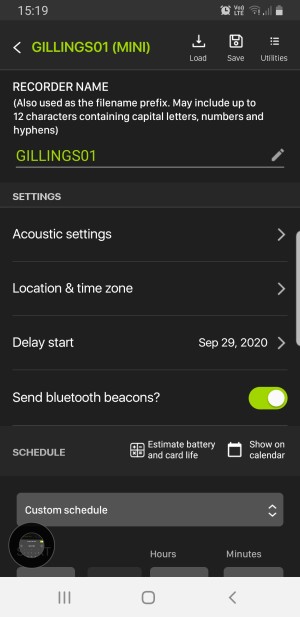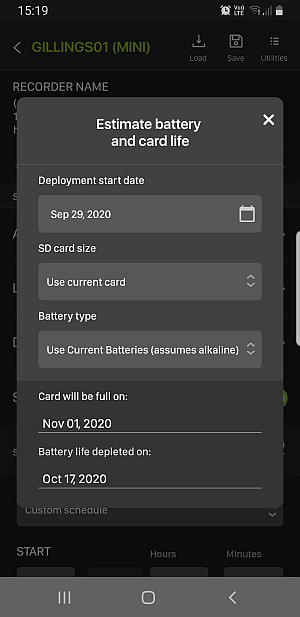Earlier this autumn I bought a Wildlife Acoustics SM4-mini to use for a long-term nocmig project in North Norfolk. I set this up with a spare fibre glass parabolic reflector that was generously given to me, to improve the range of the microphone. The whole setup was fixed to a garden shed in a coastal village and angled slightly towards the coast and away from nearby trees.
The kit
The SM4-mini is pretty compact (approx. 5″ x 6.5″ x 1.5″), runs off 4 AA batteries and takes standard SD cards. The box is rugged and waterproof and has slots and holes for attaching it to things. The setup includes a single microphone but there is a second port to add an optional second microphone for stereo recordings.
One feature I really like is the mobile app used to configure the device. The device broadcasts a Bluetooth signal which provides basic info like how many recordings have been made to date. Open the box and press the pair button and you connect your mobile app to the device to control all the settings. It is highly customisable. For example, you can configure your own on/off cycles, or allow the devise to use sunset and sunrise times as the basis of the routine.


As you’d expect, you can control the sample rate, the length of files and the gain setting. You can also set a delayed start time. On my last deployment I knew the weather was going to be horrendous for a few days so I delated the start until after the bad weather to save on battery/card life.
Given the particular batteries, card and configuration you’ve selected, the app will estimate when the batteries will be depleted and when the memory card will be full.

The sounds
So what about the recording quality? I think it is pretty good as can be judged from the following recordings:
These are cherry picked interesting examples from my most recent deployment but I think they are representative of the quality the recorder provides. The recorder has run continuously since mid August with no failures or errors. I haven’t done any side-by-side tests of this (with or without the reflector) against other recorders.
Verdict
I’m very pleased with the device for the following key reasons:
- it’s waterproof
- it’s easily programmed via a nice mobile interface
- it runs autonomously for 3 weeks (on my settings)
- it produces nice clear nocmig recordings
When I retrieve the recorder I will try to make some side-by-side recordings with other equipment.
PS: for anyone considering mounting an SM4-mini in a parabolic reflector, getting the microphone element at the precise focal point of the dish is critical. Without removing the foam windshield of the mic it is hard to know where the mic element is located, but I was told by Wildlife Acoustics that it is 16mm (±1mm) from the outside of the case.




Very interesting. I tried a similar setup with the Wildlife Acoustics SM4, but using the optional SMM-A2 mic mounted in a dish. My hope was to get a comparison between the left channel (without parabola gain) and the right mounted in the dish. Unfortunately, I have been unable to see any difference between the two, but then the number of birds recorded was not huge during my experiment. I will try again when I am in an area with more migrants.
Obviously the SM Mini in your the photo does not have an additional mic installed (so only 1 channel) and has the single omni mic in the focus of the dish. It would be interesting to know if your success is due to the omni (i.e. sound coming from any direction) or the parabola (i.e. birds calling in the focus of the parabola, with the signal boosted by the dish). I understand that parabola mics are often cardioidal, facing inward, so mainly picking up the reflected sound from the dish, which makes them more directional. It may be interesting to test the SM Mini without the dish, to test what the mic picks up directly.
LikeLike
Trying out a similar set up with a sm4 micro for nocmig.
LikeLike